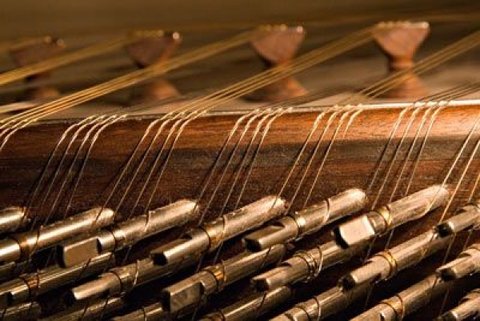This hammered- dulcimer musical instrument has a completely regular and geometric shape, generally made of walnut or maple wood. The common type of the santoor consists of 72 strings; every 4 wires has one tuning peg and each group of strings rest on a bridge (kharak); so, in fact this instrument has 18 bridges, 9 of them are on the right and 9 on the left side of the instrument.
The Santoor strings are divided into two groups of white and black wires; the white ones which are made from nickel alloy are the Drone strings and the yellow strings made from brass alloys are the Bass strings. Some researchers believe that the Santoor was originated in Persia and then had been introduced to other Asian countries a long time ago; today, similar types of this instruments is currently played in Iraq, Turkey, Syria, Egypt, Pakistan, India, Tajikistan, China, Vietnam, Korea, Ukraine and other countries of Central Asia and Greece.
The Santoor is played by two "mallet"(mezhrab) or "plectrum"(zhakhmeh). Most of the time, musicians must perform a different note with each of these mallet, so playing this instrument needs concentration of mind, beside hands agility. Musicians play the Santoor by putting their pointing fingers into a ring at one end of the mallet, then strike the strings while rotating their wrists. Framarz Payvar, is one of the famous santoor players and the first Iranian composer whose special skill was playing santoor. Many of Iranian great musicians learned Radif of Persian music from him.


Your Comment